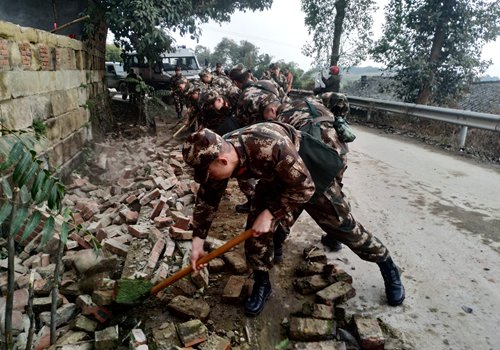
Armed police clear debris from a road in Rongxian county in Southwest Sichuan Province after two miner earthquakes occurred on Monday, killing two. (Photo: VCG)
More studies are needed to find out whether human activity can cause earthquakes, Chinese seismologists said after three deadly earthquakes on Sunday and Monday rocked a county in Southwest China's Sichuan Province, which has since halted shale gas mining after local residents protested, claiming the mining was responsible for the quakes.
Two of the earthquakes, measuring 4.3-magitude and 4.9-magnitude struck Rongxian county in Sichuan Province on Monday, killing two and injuring 12, the local government announced.
Some 1,000 residents and 2,000 onlookers gathered outside the local government office on Sunday and Monday, demanding a halt to shale gas mining, which they suspect is causing more frequent earthquakes, the government said in a post on Sina Weibo.
Seismologists, however, attributed the recent earthquakes to Rongxian's location in a region of medium seismic activity that is currently undergoing an active period, the Sichuan Earthquake Administration (SEA) said on its website.
"Rongxian's earthquakes are related to small scale faults," the SEA said, adding that more 5-magnitudes earthquakes could strike Rongxian county in the coming days.
The SEA urged residents not to believe or spread rumors, and told relevant departments to maintain normal order to maintain social stability.
Xu Xiwei, director of the Institute of Crustal Dynamics at China Earthquake Administration, told the Global Times on Tuesday that "there is no direct evidence linking exploitation of shale gas to earthquakes."
There remains concern around the world that such human activity may induce earthquakes. Xu noted that US scientists have found that the number of small and medium earthquakes has increased in areas where oil extraction and shale gas exploitation has taken place but no connection has linked the earthquakes directly to human activity.
The US Geological Survey for the first time published an earthquake hazard map in 2016 covering both natural and "human-induced" quakes. Human-induced earthquakes were associated with activities including wastewater injection, fracking and horizontal drilling to shatter subsurface shale rock, the Washington Post reported in March 2016.
Xu said that economic activity in regions that are seismically active should continue, as long as local authority closely monitors the seismic activity and strengthens the related studies.


